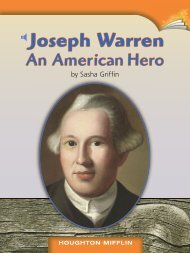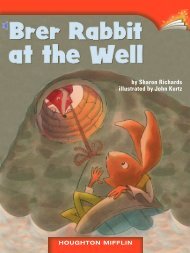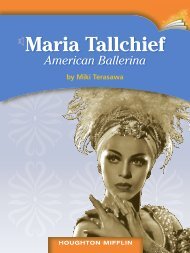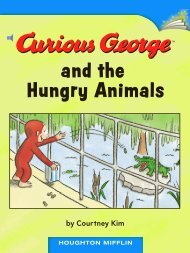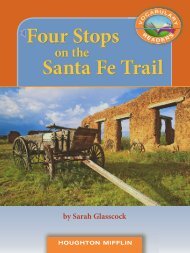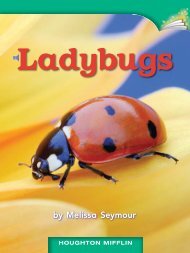Lesson 22:Galileo
Lesson 22:Galileo
Lesson 22:Galileo
Create successful ePaper yourself
Turn your PDF publications into a flip-book with our unique Google optimized e-Paper software.
HOUGHTON MIFFLIN
y Tony Pucci<br />
Cover (bkgrnd) © Antonio M. Rosario / Getty Images, (inset) © Pictorial Press Ltd / Alamy; 1 © PhotoDisc / V34<br />
Spacescapes; 2 © PhotoDisc / V34 Spacescapes; 3 © Pictorial Press Ltd / Alamy; 4 © Dimitris Tavlikos / Alamy;<br />
5 © Ioannis Mallidis / Alamy; 6 © Lawrence Manning / Corbis; 8 © Antonio M. Rosario / Getty Images; 10<br />
© Bettmann / Corbis; 11 © eStock Photo / Alamy; 13 © Stock Montage, Inc. / Alamy; 18 © PhotoDisc / V34 Spacescapes;<br />
Bkgrnd © PhotoDisc / Background Series<br />
Copyright © by Houghton Mifflin Harcourt Publishing Company<br />
All rights reserved. No part of this work may be reproduced or transmitted in any form or by any means, electronic or<br />
mechanical, including photocopying or recording, or by any information storage and retrieval system, without the prior<br />
written permission of the copyright owner unless such copying is expressly permitted by federal copyright law. Requests<br />
for permission to make copies of any part of the work should be addressed to Houghton Mifflin Harcourt School Publishers,<br />
Attn: Permissions, 6277 Sea Harbor Drive, Orlando, Florida 32887-6777.<br />
Printed in China<br />
ISBN-13: 978-0-547-02773-9<br />
ISBN-10: 0-547-02773-7<br />
1 2 3 4 5 6 7 8 0940 18 17 16 15 14 13 12 11<br />
If you have received these materials as examination copies free of charge, Houghton Mifflin Harcourt School Publishers<br />
retains title to the materials and they may not be resold. Resale of examination copies is strictly prohibited.<br />
Possession of this publication in print format does not entitle users to convert this publication, or any portion of it, into<br />
electronic format.
<strong>Galileo</strong> saw stars that we can still see today.<br />
Through the Looking Glass<br />
This is a story of courage. One brave man and his telescope<br />
changed the world. His name was <strong>Galileo</strong> (gal ih LAY oh).<br />
Most people are full of wonder when they look at the night sky.<br />
The sky probably filled <strong>Galileo</strong> with wonder, too.<br />
Great thinkers of the past wanted to study the moon,<br />
stars, and planets. It was hard to do this before the telescope<br />
was invented.<br />
2
So these thinkers made up their own ideas about the<br />
universe. They based their ideas on beliefs, not on facts.<br />
<strong>Galileo</strong> changed all that. He shocked the world with what<br />
he saw using his telescope.<br />
<strong>Galileo</strong>: From Student to Teacher<br />
<strong>Galileo</strong> was born in Italy in<br />
1564. He was the oldest of seven<br />
children. His father was a music<br />
teacher. <strong>Galileo</strong>’s father knew that<br />
his son was very smart. He wanted<br />
<strong>Galileo</strong> to be a doctor. So at age 11,<br />
<strong>Galileo</strong> went to school. Priests<br />
lived and taught at his school.<br />
<strong>Galileo</strong> studied there for six<br />
years. Then he decided to become<br />
a priest, too.<br />
His father did not want<br />
<strong>Galileo</strong> to be a priest. He sent<br />
<strong>Galileo</strong> to the University of Pisa to<br />
become a doctor. But <strong>Galileo</strong> didn’t<br />
want to be a doctor. The only class<br />
he liked was math. The rest of his<br />
grades were low. <strong>Galileo</strong> dropped<br />
out of school. His father was<br />
very disappointed.<br />
<strong>Galileo</strong> made many<br />
scientific discoveries.<br />
3
statue of Aristotle<br />
Aristotle was one of the greatest thinkers of all time.<br />
<strong>Galileo</strong> needed a job. So he helped students with their<br />
math. <strong>Galileo</strong> worked very hard. A few years later, he returned<br />
to the University of Pisa. This time he was a math professor, not<br />
a student. <strong>Galileo</strong> was very good in math. But the school made<br />
him pay several fines.<br />
4
<strong>Galileo</strong> had to pay the fines because he refused to wear a<br />
black robe. All the school’s teachers were supposed to wear one.<br />
Imagine the school’s frustration with <strong>Galileo</strong>!<br />
At that time, people at the university debated the idea of<br />
gravity. Gravity is the force that<br />
pulls on objects. They also talked<br />
about Aristotle, who lived long<br />
ago in ancient Greece. Aristotle<br />
was a famous teacher and thinker.<br />
Suppose someone dropped<br />
two balls at the same time.<br />
Aristotle said that gravity made<br />
the heavier ball land first. This<br />
seemed to make sense. People<br />
accepted this idea, or theory,<br />
as fact.<br />
<strong>Galileo</strong> was different.<br />
He wasn’t sure this idea was<br />
really true. <strong>Galileo</strong> liked to do<br />
experiments. He wanted to<br />
prove an idea was a fact first.<br />
Only then would he believe it.<br />
<strong>Galileo</strong> decided to test Aristotle’s<br />
theory about gravity.<br />
The Tower of Pisa still<br />
The conditions for <strong>Galileo</strong>’s stands today.<br />
experiment were simple. First, he<br />
needed to find a tall building. He<br />
chose the tower of Pisa.<br />
5
telescope<br />
lens<br />
<strong>Galileo</strong>’s telescope made him rich and famous.<br />
The Tower of Pisa lurched, or leaned, a bit, so it wasn’t<br />
truly vertical, or straight up and down. Still, it would do. Then<br />
he needed balls of different weights to drop.<br />
<strong>Galileo</strong> climbed to the top of the tower. He dropped two<br />
balls of different weights at the exact same time. What do you<br />
think happened Both balls hit the ground at the same time.<br />
Aristotle was wrong. <strong>Galileo</strong> had just proved it.<br />
It is not known if <strong>Galileo</strong> really did the experiment in<br />
this way. But we do know that people still believed Aristotle’s<br />
theory! No one praised <strong>Galileo</strong> for his experiment. In fact, he<br />
got fired from his job. But <strong>Galileo</strong> was very talented. He quickly<br />
got a new teaching job at another school. It was one of the best<br />
schools in all of Europe.<br />
6
The Telescope<br />
<strong>Galileo</strong> was happy at his new job. He earned a good salary.<br />
Still, he needed more money. His father was now dead, so<br />
<strong>Galileo</strong> was head of the family. To earn more money, <strong>Galileo</strong><br />
invented many things. His inventions earned him the money<br />
he so badly needed. But one invention changed his life — the<br />
telescope.<br />
A Dutch eye doctor invented the first telescope by accident.<br />
It let him see things far away more clearly. <strong>Galileo</strong> heard about<br />
it. He was very excited. His instinct, or natural feeling, told him<br />
that this invention was very important. <strong>Galileo</strong> never saw the<br />
doctor’s telescope. But he built one that worked much better.<br />
As a result, many people think of <strong>Galileo</strong> as the inventor of<br />
the telescope.<br />
<strong>Galileo</strong> began to study the night skies with his telescope.<br />
When he looked at the moon, he saw something shocking.<br />
Aristotle said long ago that the surface of the moon was barren,<br />
or empty, and smooth. But Aristotle was wrong again. The<br />
moon has deep valleys and high mountains.<br />
<strong>Galileo</strong> also looked at the sun with his telescope. He<br />
saw that it had dark spots. Today, we call these dark patches<br />
sunspots. Gases on the surface of the sun explode and cause<br />
these spots. <strong>Galileo</strong> spent so much time looking right at the sun<br />
that it likely damaged his eyes.<br />
7
Jupiter<br />
<strong>Galileo</strong> made discoveries about Jupiter with his telescope.<br />
<strong>Galileo</strong> was also surprised when he looked at Jupiter. It had<br />
four moons moving around it. That seemed impossible! <strong>Galileo</strong><br />
saw rings around the planet Saturn. He also saw more stars<br />
with his telescope than he could see with just his eyes.<br />
8
<strong>Galileo</strong>’s discoveries were a sensation. In today’s world,<br />
his face would be on the cover of every magazine. People were<br />
impressed with his findings.<br />
<strong>Galileo</strong>’s New Ideas<br />
<strong>Galileo</strong> wrote a book about his findings. It was called<br />
The Starry Messenger. It was a huge hit. In the book, he said that<br />
many of Aristotle’s ideas were wrong. This was a surprise to<br />
many readers. <strong>Galileo</strong> also hinted that Aristotle was wrong<br />
about Earth being the center of the universe. That was the<br />
biggest surprise of all.<br />
<strong>Galileo</strong> now had plenty of money. So he quit his teaching<br />
job and moved to Florence. People throughout Europe called<br />
<strong>Galileo</strong> a great inventor and scientist. But some people didn’t<br />
like what he had to say. Some of his findings angered the<br />
Catholic Church. <strong>Galileo</strong> needed to be careful.<br />
<strong>Galileo</strong>’s Split with the Church Widens<br />
<strong>Galileo</strong> did not mean to cause problems for the Church.<br />
He was a just a scientist looking for facts. But the Church used<br />
Aristotle’s ideas as a part of its teachings. So some people<br />
thought he was attacking the Church when he said Aristotle<br />
was wrong. <strong>Galileo</strong> was headed for trouble.<br />
9
Maria Mitchell’s<br />
Comet<br />
Maria Mitchell was born in<br />
1818. Her father was a teacher.<br />
He taught Maria about the<br />
stars and planets. He wanted<br />
her to follow her interest<br />
in math and astronomy.<br />
One night, Maria saw<br />
something unusual when she<br />
looked through her telescope.<br />
She saw a new star in the sky.<br />
Maria Mitchell<br />
She was sure it had not been<br />
discovered a comet there the night before. The<br />
with her telescope.<br />
next night the star was in a<br />
new place. What was this elusive star that was so hard to<br />
find Maria Mitchell had discovered a new comet! A comet<br />
looks like a fuzzy star with a tail of light. People now call<br />
her discovery “Miss Mitchell’s Comet.”<br />
Later, Maria Mitchell became the first woman<br />
professor of astronomy in the United States. She received<br />
many awards. Some say she was the most famous scientist<br />
of the 1800s.<br />
10
Aristotle’s theory was that the earth was the center of the<br />
universe. People still believed him. So did the Church. But one<br />
man had a different idea. His name was Nicholas Copernicus<br />
(kuh PERN ih kus).<br />
Copernicus was a doctor. He wrote a famous book in 1543.<br />
In it, he said that the sun was the center of the universe. The book<br />
also said that Earth moved around the sun. At the time, it was<br />
only a theory. But <strong>Galileo</strong>’s work now proved this theory. Serious<br />
objections arose, or came from, the Church. The Church leaders<br />
believed that the Bible supported the views of Aristotle.<br />
Copernicus thought that Earth moved around the sun.<br />
The Solar System<br />
11
<strong>Galileo</strong> agreed with Copernicus. Some people didn’t like<br />
that. One woman from a powerful family attacked <strong>Galileo</strong>.<br />
She said that he was wrong because the things he observed<br />
went against the teachings of the Bible.<br />
<strong>Galileo</strong> tried to calm people down. He explained his<br />
ideas in a letter to a friend. He agreed that the Bible couldn’t<br />
be wrong. But he thought the people who interpreted, or<br />
explained, the Bible could be wrong. He also hinted that Church<br />
leaders could make mistakes explaining the Bible. These words<br />
would come back to haunt him.<br />
The Church Investigates <strong>Galileo</strong><br />
A few years later, the Church leaders called <strong>Galileo</strong> to<br />
Rome. This was a bad sign. The Church was very powerful<br />
in those days. Their rulings had the force of law. Church<br />
leaders remembered <strong>Galileo</strong>’s letter. They accused <strong>Galileo</strong><br />
of a crime called heresy (HAYR uh see). Heresy is a belief in<br />
false teachings.<br />
A person found guilty of this crime could get a harsh<br />
punishment. Church leaders often sent them to prison.<br />
They usually took away all of the person’s belongings, too.<br />
Sometimes, a person who did not admit his or her guilt<br />
was killed.<br />
<strong>Galileo</strong> had to answer many questions. This questioning<br />
went on for days. Finally, the Church leaders found <strong>Galileo</strong><br />
innocent. But they did not like <strong>Galileo</strong>’s ideas. They also said<br />
that Copernicus’s ideas were “foolish.”<br />
12
Punished for Heresy<br />
Before <strong>Galileo</strong>, the Church<br />
found a man named Bruno guilty<br />
of heresy. Bruno said that the sun<br />
was the center of the universe.<br />
This was a crime. Church leaders<br />
sentenced Bruno to death.<br />
Church leaders punished a man<br />
named Bruno for heresy.<br />
Church leaders made it against the law to read<br />
Copernicus’s book. They said it was a crime to say that the sun<br />
was the center of the universe. The Church told <strong>Galileo</strong> not to<br />
discuss this idea as a fact. If he did, they would send <strong>Galileo</strong><br />
to prison. The Church also told him not to defend Copernicus.<br />
<strong>Galileo</strong> Returns to Work<br />
<strong>Galileo</strong> went back to his telescope. He still wrote about<br />
what he found. Church leaders kept a close eye on his work.<br />
Three bright comets appeared in the sky in 1618. <strong>Galileo</strong> hoped<br />
that these comets would prove that Copernicus was right.<br />
But Church leaders disagreed with <strong>Galileo</strong>.<br />
13
<strong>Galileo</strong>’s Career<br />
1564: Birth of <strong>Galileo</strong><br />
1581: Student at University of Pisa<br />
1589: Begins teaching at University of Pisa<br />
1592: Goes to University of Padua<br />
1609: Invention of telescope<br />
1610: The Starry Messenger published<br />
1615:<br />
Accused of heresy; told not<br />
to defend Copernicus<br />
1632: <strong>Galileo</strong>’s second book published<br />
1633: Sentenced to life imprisonment<br />
1642: Death of <strong>Galileo</strong><br />
14
Then, a good friend of <strong>Galileo</strong> became the Pope. The Pope<br />
is the head of the Catholic Church. <strong>Galileo</strong> saw this as a chance<br />
to make friends with Church leaders. He visited the Pope many<br />
times. Still, his old friend did not support <strong>Galileo</strong>’s viewpoints.<br />
<strong>Galileo</strong> was disappointed. Yet, he thought there was still a way<br />
to write about the ideas of Copernicus. <strong>Galileo</strong> decided to<br />
present the ideas as theories, not as facts.<br />
The Trial<br />
In 1632, <strong>Galileo</strong> wrote another book. It was a fictional story.<br />
In it, three characters talk about Copernicus’s theories. The<br />
smartest character agrees with Copernicus. The second one has<br />
an open mind. The third character will not change his mind<br />
about anything.<br />
The book was a huge success. A Church leader approved<br />
the book before <strong>Galileo</strong> published it. But the Pope stopped the<br />
printer from making more books. He thought <strong>Galileo</strong> broke<br />
his promise not to write about the ideas of Copernicus as facts.<br />
Church leaders called <strong>Galileo</strong> to Rome again.<br />
<strong>Galileo</strong> was sick at the time. He asked the Pope to delay his<br />
trial. But <strong>Galileo</strong>’s old friend refused. He said <strong>Galileo</strong> had to go<br />
to Rome. Otherwise, <strong>Galileo</strong> would be put in chains and forced<br />
to come.<br />
15
The Search Goes On<br />
Today, people use telescopes that are much more<br />
powerful than the ones <strong>Galileo</strong> used. One group uses them<br />
to search for life on other planets. Jill Tarter is the leader<br />
of this group. In all likelihood, Tarter has looked through<br />
a telescope more than anyone else.<br />
Jane Jordan works with Tarter. Jordan is building a new<br />
telescope. This one will see farther into space than ever<br />
before. Maybe these scientists will make discoveries that<br />
change the way we view the world. That’s what <strong>Galileo</strong> did.<br />
<strong>Galileo</strong>’s second trial lasted about two months. He hoped<br />
to get a light sentence. He tried to explain his book to the Pope.<br />
But the Pope wouldn’t listen. Church leaders found <strong>Galileo</strong><br />
guilty of heresy. They sentenced him to spend the rest of his<br />
life under house arrest. He could never leave his home again.<br />
Church leaders also forced him to admit that Earth did not<br />
move around the sun. Today, we know that it does.<br />
The Final Years<br />
After the trial, <strong>Galileo</strong> slowly made his way back home.<br />
He was now a decrepit man. <strong>Galileo</strong> was old, feeble, and sad.<br />
He could never talk about Copernicus again. Still, <strong>Galileo</strong> went<br />
back to work. Near the end of his life, <strong>Galileo</strong> went totally blind.<br />
He died in 1642.<br />
16
Almost 200 years later, Church leaders finally looked<br />
at <strong>Galileo</strong> in a new light. They lifted the ban on his books.<br />
We now know that <strong>Galileo</strong> was right all along. The sun, not<br />
Earth, is the center of the universe. In 1992, new Church leaders<br />
declared that <strong>Galileo</strong> was innocent of all crimes.<br />
Journey to Jupiter<br />
In 1989, NASA sent a U.S. spacecraft to explore Jupiter.<br />
They named the spacecraft <strong>Galileo</strong>. This name honored the first<br />
person to see Jupiter through a telescope.<br />
The <strong>Galileo</strong> traveled through space to get to Jupiter. It took<br />
six years to get there. A smaller spacecraft launched from the<br />
<strong>Galileo</strong> landed on the planet. It sent a lot of information about<br />
Jupiter back to Earth.<br />
A large team of scientists studied the <strong>Galileo</strong>’s findings.<br />
They learned a lot about Jupiter and its moons. Long ago, <strong>Galileo</strong><br />
saw that Jupiter had four moons. We now know that Jupiter has<br />
63 moons. There may still be more moons to discover!<br />
<strong>Galileo</strong> Today<br />
People say <strong>Galileo</strong> was one of the founders of modern<br />
science. He was unlike most scientists before him. He used<br />
experiments to find the truth. He knew the difference between<br />
a theory and a fact. The things he saw changed the way people<br />
looked at the universe.<br />
17
astronaut<br />
What would <strong>Galileo</strong> say if he knew that<br />
humans walked on the moon<br />
Today, a space station moves around the Earth. Do you<br />
think this would surprise <strong>Galileo</strong> What do you think he would<br />
say about the future of space exploration What do you say<br />
about its future<br />
18
Responding<br />
TARGET SKILL Conclusions and<br />
Generalizations How did <strong>Galileo</strong>’s telescope<br />
change the world Copy the chart below.<br />
Write your conclusion at the bottom. Then list<br />
examples that support your conclusion.<br />
<strong>Galileo</strong> saw<br />
that Saturn<br />
had rings.<br />
<strong>Galileo</strong> saw<br />
that Jupiter<br />
had four<br />
moons.<br />
Examples:<br />
<br />
<br />
Conclusion: <br />
Write About It<br />
Text to Text <strong>Galileo</strong>’s findings caused problems<br />
with Church leaders. Think of another book<br />
you have read about someone’s ideas causing<br />
problems. Write a paragraph that explains how<br />
the character in that book solved the problems.<br />
19
TARGET VOCABULARY<br />
arose<br />
barren<br />
conditions<br />
decrepit<br />
elusive<br />
frustration<br />
harsh<br />
instinct<br />
lurched<br />
vertical<br />
TARGET SKILL Conclusions and<br />
Generalizations Use details to explain ideas that<br />
aren’t stated or are generally true.<br />
TARGET STRATEGY Monitor/Clarify As you read,<br />
notice what isn’t making sense. Find ways to figure<br />
out the parts that are confusing.<br />
GENRE Narrative Nonfiction gives factual<br />
information by telling a true story.<br />
Write About It<br />
In a famous quotation, Aung San Suu Kyi said,<br />
“Please use your freedom to promote ours.”<br />
What freedoms do you value most Why Write<br />
a letter to the editor of a Burmese newspaper<br />
explaining the freedoms you have and why they<br />
are important to you.<br />
20
Level: W<br />
DRA: 60<br />
Genre:<br />
Narrative Nonfiction<br />
Strategy:<br />
Monitor/Clarify<br />
Skill:<br />
Conclusions and Generalizations<br />
Word Count: 2,592<br />
6.5.<strong>22</strong><br />
HOUGHTON MIFFLIN<br />
Online Leveled Books<br />
1032846





